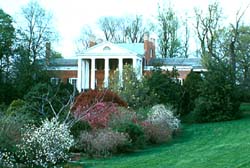
Oak Hill is a mansion and plantation located in Aldie, Virginia that was for 22 years a home of James Monroe, the fifth U.S. President. It is located approximately 9 miles (14 km) south of Leesburg on U.S. Route 15, in an unincorporated area of Loudoun County, Virginia. Its entrance is 10,300 feet (3,100 m) north of Gilberts Corner, the intersection of 15 with U.S. Route 50. It is a National Historic Landmark, but privately owned and not open to the public.

SS Red Oak Victory is a U.S. military Victory ship of the Boulder Victory-class cargo ship used in the Second World War. She was preserved to serve as a museum ship in Richmond, California, and is part of the Rosie the Riveter/World War II Home Front National Historical Park. She was one of 534 Victories built during World War II, but one of only a few of these ships to be transferred from the Merchant Marine to the United States Navy. She was named after Red Oak, Iowa, which suffered a disproportionate number of casualties in early World War II battles.. The ship was active during World War II, the Korean War, and the Vietnam War.

The John Muir National Historic Site is located in the San Francisco Bay Area, in Martinez, Contra Costa County, California. It preserves the 14-room Italianate Victorian mansion where the naturalist and writer John Muir lived, as well as a nearby 325-acre tract of native oak woodlands and grasslands historically owned by the Muir family. The main site is on the edge of town, in the shadow of State Route 4, also known as the "John Muir Parkway."
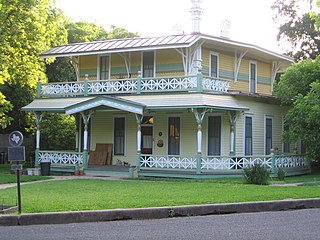
The Shadow Lawn Historic District is a historic district in central Austin, Texas that boasts a cohesive collection houses built in the southeast portion of Hyde Park during the late 1920s and 1930s.
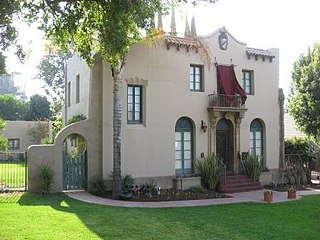
The Upton Sinclair House is a historic house at 464 N. Myrtle Avenue, Monrovia, California. Built in 1923, it was the home of American novelist Upton Sinclair (1878-1968) between 1942 and 1966, and is where he wrote many of his later works. It was listed on the National Register of Historic Places and was declared a National Historic Landmark in 1971. It is a private residence.

The Morgan–Manning House is a historic house located in Brockport, Monroe County, New York. It was built in 1854 and is a two-story, Italianate–style brick dwelling on a limestone foundation. The five-by-four-bay main block features a hipped roof and cupola. It has a two-story hipped roof wing with a smaller two-story brick appendage creating a stepped, or telescoping, plan or profile. The house also has a full width porch with brick piers. The interior features elaborate interior woodwork, period plasterwork, stained glass and decorated ceilings. Also on the property is a contributing carriage house.

The Peter A. Beachy House is a home in the Chicago suburb of Oak Park, Illinois that was entirely remodeled by architect Frank Lloyd Wright in 1906. The house that stands today is almost entirely different from the site's original home, a Gothic cottage. The home is listed as a contributing property to the Frank Lloyd Wright-Prairie School of Architecture Historic District, which was listed on the U.S. National Register of Historic Places.

The James Monroe Museum and Memorial Library is a historic museum at 908 Charles Street in Fredericksburg, Virginia. It is located on the site of the James Monroe Law Office, used by future United States President James Monroe from 1786 to 1789. It was declared a National Historic Landmark in 1966. It is now owned by the Commonwealth of Virginia and operated by the University of Mary Washington. The museum features original objects and memorabilia related to James Monroe, and includes several items relating to other members of his family, including dresses worn by First Lady Elizabeth Monroe.

The Charter Oak Schoolhouse is a historic octagonal school building in Schuline, Illinois, located on the Evansville/Schuline Road between Schuline and Walsh. Built in 1873, it served as a public primary school until 1953. The school was one of 53 octagonal schoolhouses built in the United States, of which only three survive. The building is now used as a museum by the Randolph County Historical Society and is listed on the National Register of Historic Places.
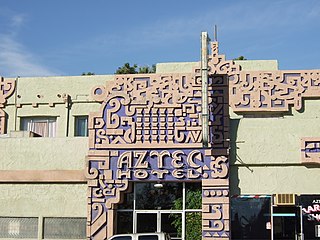
The Aztec Hotel is a historical landmark building in Monrovia, in the San Gabriel Valley, California. The hotel is an example of Mayan Revival architecture still in existence. It was designed by architect Robert Stacy-Judd, and built on U.S. Route 66 in 1924. The hotel was closed for renovations in 2012.

The Sawyer House, also known as the Sawyer Homestead and in its previous incarnation as the Navarre House, is a city-owned house located at 320 East Front Street in Monroe, Michigan. It was listed as a Michigan Historic Site on June 19, 1975. The house was listed on the National Register of Historic Places on November 23, 1977 and is also part of the larger Old Village Historic District.

Mount Vernon A.M.E. Church, also known as Mount Vernon African Methodist Episcopal Church, is a historic church located north of Gamaliel, Kentucky on Kentucky Route 100. It was added to the National Register of Historic Places in 1977.

The Walker Tavern is a historic structure located at 11710 U.S. Route 12 in Cambridge Township in northwesternmost Lenawee County, Michigan. It was designated as a Michigan Historic Site on February 19, 1958 and was later the county's first property added to the National Register of Historic Places on January 25, 1971. The structure was incorporated into the Cambridge Junction Historic State Park and continues to serve as a museum and venue for various events.
William Norton Monroe, known as William N. Monroe or W.N. Monroe, (1841–1935) was a school teacher, U.S. Army officer, a railroad builder for the Southern Pacific, and the founder of Monrovia, California. He was also a member of the Los Angeles Common Council, the legislative branch of the city.

James Monroe Family Home Site, also known as James Monroe's Birthplace, is a historic archaeological site located near Oak Grove and Colonial Beach, Westmoreland County, Virginia. The site includes the ruins of the Monroe Family Home and birthplace of President James Monroe (1758-1831), which were uncovered in 1976, by a team from the College of William & Mary. Monroe spent his entire youth working the farm until he left for his education at the College of William & Mary. The archaeological team uncovered a house foundation measuring 20 feet by 58 feet. The known 1845 etchings of the birth home indicate a small four room, rough cut wooden farm house with few outbuildings on a 500-acre farm filled with wetlands. The archaeological study clearly indicated that James Monroe's beginnings were humble.

Cantol Wax Company Building, also known as Oakes Manufacturing Company Building and Wylie's Furniture Warehouse, is a historic industrial / commercial building located at Bloomington, Monroe County, Indiana. It was built between about 1905 and 1907, and consists of a 3 1/2-story, rectangular, front section, and 2 1/2-story rear addition. The masonry building has a rubble limestone foundation, terra cotta block walls, and Classical Revival style design elements. It was originally constructed for the Oakes Manufacturing Company, then housed the Cantol Wax Company after 1920.
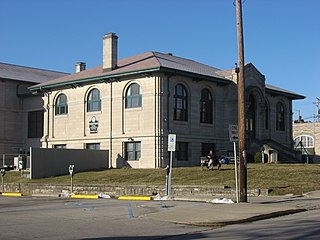
Monroe Carnegie Library, also known as Old Monroe Carnegie Library, is a historic Carnegie library located at Bloomington, Monroe County, Indiana. It was built in 1917, and is a one-story, rectangular, Neoclassical style limestone building on a raised basement. The Monroe County History Center is a history museum the historic library building that was established as a Carnegie library. The museum is located on the site of Center School in the former Bloomington Public Library building. The library building is now home to the Monroe County Historical Society, their collection of artifacts, and their Genealogy Library. A historical marker is present at the site. The History Center is located at 202 East 6th Street. It is a tourist attraction.

The Hyde-St. John House is a historic house at 25 Charter Oak Avenue in Hartford, Connecticut. Built in 1858, it is one of the city's least-altered examples of Italianate architecture, and it was home to prominent local attorney and city mayor William Waldo Hyde. It was listed on the National Register of Historic Places in 1977, and is presently in commercial use.


























